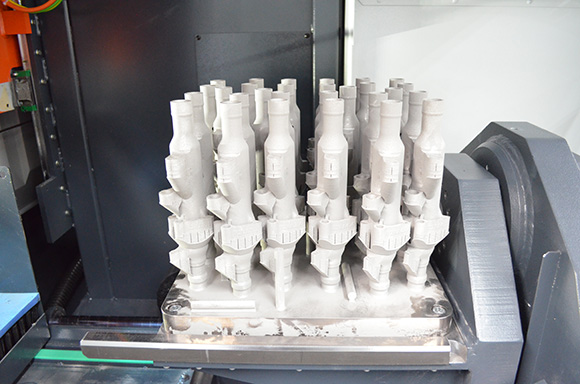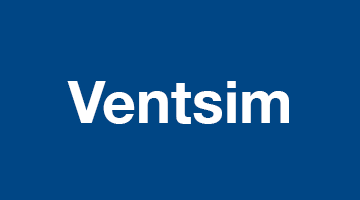To save time and costs during the production of aircraft components, Airbus Helicopters, which is headquartered in Bavaria, has recently turned to additive manufacturing. After manufacturing the titanium components in a 3D printer, the next step is to separate them from their baseplates, which is done using a fully automatic KASTOwin amc bandsaw.
Click to download and read pdf
There is barely any other sector that takes the issue of lightweight construction as seriously as the aviation industry – and with good reason. Every gram that can be trimmed off an aircraft’s weight helps achieve considerable long-term fuel savings. This benefits both airlines and manufacturers, who are able to compete for orders by offering ever more lightweight constructions. However, aircraft components not only have to be light; they also have to be stable and absolutely reliable. That is why special high-tech materials and innovative manufacturing methods are becoming increasingly widespread in their production.
Airbus Helicopters is also consistently searching for innovative lightweight construction solutions. The company, which has its head office in Donauwörth in Bavaria, is part of the Airbus Group, Europe’s largest aviation and aerospace company. The site, which has a workforce of approximately 7 000 employees, not only develops and produces a range of helicopter models such as the H135 and H145, it also specialises in the manufacture of aircraft doors. In Donauwörth, Airbus Helicopters manufactures more than 4 000 passenger and cargo doors every year.
Layer by layer: manufacturing 3D-printed components
Recently, Airbus has been using an additive manufacturing process to produce shafts for locking these doors. The titanium components are created in a 3D printer, which applies layer after layer of the powdery input material to a baseplate measuring 400×400 mm. The fact that the walls of the shaft are so thin and that the component’s geometry is complex makes this manufacturing method particularly suitable. It cuts production costs as well as work and effort, which is most important since 16 of these components are installed in every A350. The 3D-printing process enables total saving of slightly more than 4.0 kg per aircraft.
When the printing of the components is finished, they must be separated from the baseplate, which is also made of titanium. To perform this process, Airbus has invested in the KASTOwin amc fully automatic bandsaw. The KASTO machine has been in operation in Donauwörth since October 2018. What makes it so special? It has been specifically designed for the machining of additively manufactured parts, most notably, separating the parts from the base plate.
Sawing upside down prevents damage
An employee uses an electric lift truck to remove the baseplate and shafts, which can weigh up to 40 kg, from the 3D printer before transporting the workpiece to the saw and placing it on the clamping mechanism. Here, the plate is fastened in place extremely securely with thick screws and the machine is sealed so no fine dust can escape.
What happens next is rather unusual: the entire mechanism rotates through 180° in preparation for the sawing operation. The components are therefore sawn upside down. This concept offers considerable advantages for additive manufacturing. While being cut, the parts cannot topple over or buckle, which prevents damage that could lead to time-intensive rework and expensive scrap levels.
Before the sawing operation begins, the employee measures the thickness of the clamped baseplate and enters this using the job wizard of the machine’s AdvancedControl control system. The saw, which is equipped with a high-precision ball screw spindle drive, then moves to the exact height required. Because the plates can be reused many times and are ground flat again after each operation, they become thinner the more they are used.
The intelligent control system makes it possible to saw the parts precisely to the corresponding dimensions for each individual operation. This reduces reworking effort and saves material – a cost factor that cannot be underestimated when working with a material such as titanium.
Fully sealed enclosure protects users
When cutting is complete, the shafts fall into a container specially provided for this purpose. It is padded to prevent damage. The operator the shafts through a flap so they can be passed onto the next machining step.
The KASTOwin amc bandsaw is fully enclosed to prevent ambient air from becoming contaminated with tiny particles, which are detrimental to health and may arise during the machining of additively manufactured components. The machine also comes ready to be connected to an extraction system. It therefore complies with the most exacting requirements regarding occupational safety and operator protection.
Before opting for the KASTO machine, Airbus’s decision-makers conducted a number of trial cuts at the saw technology specialist’s premises at Achern in Baden-Wuerttemberg and were very impressed by the results. Sawing the titanium plates proved to be significantly more cost-efficient than alternative machining methods such as milling or electrical discharge cutting.
Compared to other plant and machinery in the giant factory hall, the KASTOwin is also extremely compact and space-saving. It is easy to use and is appreciated for its short cutting times and the outstanding results it achieves.
For Airbus, the changeover to the 3D printing process and the acquisition of the KASTOwin amc have already paid for themselves: The shafts, which are now widely used to lock aircraft doors, are between 45% and 25% more economical to manufacture than conventional components.
Airbus Helicopters currently manufactures approximately 2 200 of these titanium components at its factory in Donauwörth. The additive manufacturing of other components is also planned for the future – meaning that the KASTO saw will play an even more prominent role in the production process.
Photos courtesy: KASTO Maschinenbau GmbH & Co. KG.














